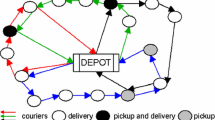Abstract
We combine mixed integer linear programming (MILP) and constraint programming (CP) to minimize tardiness in planning and scheduling. Tasks are allocated to facilities using MILP and scheduled using CP, and the two are linked via logic-based Benders decomposition. We consider two objectives: minimizing the number of late tasks, and minimizing total tardiness. Our main theoretical contribution is a relaxation of the cumulative scheduling subproblem, which is critical to performance. We obtain substantial computational speedups relative to the state of the art in both MILP and CP. We also obtain much better solutions for problems that cannot be solved to optimality.
Similar content being viewed by others
References
Benders, J. F. (1962). Partitioning procedures for solving mixed-variables programming problems. Numerische Mathematik, 4, 238–252.
Cambazard, H., Hladik, P.-E., Déplanche, A.-M., Jussien, N., & Trinquet, Y. (2004). Decomposition and learning for a hard real time task allocation problem. In M. Wallace (Ed.), Principles and practice of constraint programming (CP2004), Volume 3258 of Lecture Notes in Computer Science (pp. 153–167). Berlin Heidelberg New York: Springer.
Chu, Y., & Xia, Q. (2004). Generating benders cuts for a class of integer programming problems. In J. C. Régin & M. Rueher (Eds.), Integration of AI and OR techniques in constraint programming for combinatorial optimization problems (CPAIOR 2004), volume 3011 of Lecture Notes in Computer Science (pp. 127–141). Berlin Heidelberg New York: Springer.
Corréa, A. I., Langevin, A., & Rousseau, L. M. (2004). Dispatching and conflict-free routing of automated guided vehicles: A hybrid approach combining constraint programming and mixed integer programming. In J. C. Régin & M. Rueher (Eds.), Integration of AI and OR Techniques in Constraint Programming for Combinatorial Optimization Problems (CPAIOR 2004), volume 3011 of Lecture Notes in Computer Science (pp. 370–378). Berlin Heidelberg New York: Springer.
Eremin, A., & Wallace, M. (2001). Hybrid Benders decomposition algorithm in constraint logic programming. In T. Walsh (Ed.), Principles and practice of constraint programming (CP2001), volume 2239 of Lecture Notes in Computer Science (pp. 1–15). Berlin Heidelberg New York: Springer.
Geoffrion, A. M. (1972) Generalized benders decomposition. Journal of Optimization Theory and Applications, 10, 237–260.
Harjunkoski, I., & Grossmann, I. E. (2001). A decomposition approach for the scheduling of a steel plant production. Computers and Chemical Engineering, 25, 1647–1660.
Hooker, J. N. (2000). Logic-based methods for optimization: combining optimization and Constraint Satisfaction. New York: Wiley.
Hooker, J. N. (2004). A hybrid method for planning and scheduling. In M. Wallace (Ed.), Principles and practice of constraint programming (CP2004), volume 3258 of Lecture Notes in Computer Science (pp. 305–316). Berlin Heidelberg New York: Springer.
Hooker, J. N. (2005). A hybrid method for planning and scheduling. Constraints, 10, 385–401.
Hooker, J. N. (2005). Planning and scheduling to minimize tardiness. In Principles and practice of constraint programming (CP2005), Lecture Notes in Computer Science. Berlin Heidelberg New York: Springer.
Hooker, J. N., & Ottosson, G. (2003). Logic-based Benders decomposition. Mathematical Programming, 96, 33–60.
Hooker, J. N., & Yan, H. (1995). Logic circuit verification by benders decomposition. In V. Saraswat & P. Van Hentenryck (Eds.), Principles and practice of constraint programming: The Newport Papers (pp. 267–288). Cambridge, Massachusetts: MIT.
Hooker, J. N., & Yan, H. (2002). A relaxation for the cumulative constraint. In P. Van Hentenryck (Ed.), Principles and practice of constraint programming, volume 2470 of Lecture Notes in Computer Science (pp. 686–690). Berlin Heidelberg New York: Springer.
Jain, V., & Grossmann, I. E. (2001). Algorithms for hybrid MILP/CP models for a class of optimization problems. INFORMS Journal on Computing, 13, 258–276.
Maravelias, C. T., & Grossmann, I. E. (2004). Using MILP and CP for the scheduling of batch chemical processes. In J. C. Régin & M. Rueher (Eds.), Integration of AI and OR Techniques in Constraint Programming for Combinatorial Optimization problems (CPAIOR 2004), volume 3011 of Lecture Notes in Computer Science (pp. 1–20). Berlin Heidelberg New York: Springer.
Thorsteinsson, E. (2001). Branch and check: A hybrid framework integrating mixed integer programming and constraint logic programming. In T. Walsh (Ed.), Principles and practice of constraint programming (CP2001), volume 2239 of Lecture Notes in Computer Science (pp. 16–30). Berlin Heidelberg New York: Springer.
Timpe, C. (2002). Solving planning and scheduling problems with combined integer and constraint programming. OR Spectrum, 24, 431–448.
Türkay, M., & Grossmann, I. E.(1996). Logic-based MINLP algorithms for the optimal synthesis of process networks. Computers and Chemical Engineering, 20, 959–978.
Xia, Q., Eremin, A., & Wallace, M. (2004). Problem decomposition for traffic diversions. In J. C. Régin & M. Rueher (Eds.), Integration of AI and OR Techniques in Constraint Programming for Combinatorial Optimization Problems (CPAIOR 2004), volume 3011 of Lecture Notes in Computer Science (pp. 348–363). Berlin Heidelberg New York: Springer.
Author information
Authors and Affiliations
Corresponding author
Rights and permissions
About this article
Cite this article
Hooker, J.N. An Integrated Method for Planning and Scheduling to Minimize Tardiness. Constraints 11, 139–157 (2006). https://doi.org/10.1007/s10601-006-8060-2
Published:
Issue Date:
DOI: https://doi.org/10.1007/s10601-006-8060-2




